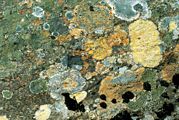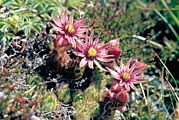Water relations of special plant types
Desiccation tolerant plants can lose all water but resume activity at when re-wet: algae, lichens, and mosses.
Dry mountain habitats permit slow growing succulents to thrive. Some stay small such as Sempervivum montanum (Fig. 2), others, such as this giant cactus at 3000 m in the Argentinean Andes (Fig. 3), get very big. Both have in common
- water storage
- CAM metabolism
What is CAM (Crassulaceaen acid metabolism)? CAM plants are able to absorb CO2 during the night (open stomata, little vapour loss) and store it as carbonic acid in their cell sap. During the day, the stored CO2 is used for photosynthesis while stomata remain closed.
Cushion plants have their "private" compost heap which stores a lot of water and nutrients (Fig. 4). Such compact cushions are often found on poor, underdeveloped substrates.




